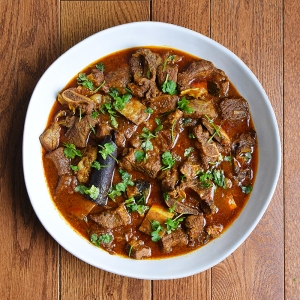
Another week, another beef curry. I made this slow-cooked curry the week before I left for Delhi (where I will be for another week) and the family instructed me in no uncertain terms to immediately write down exactly how I made it so that I can make it again. I think I may have mentioned before that when not cooking expressly for the blog I rarely make the same thing twice in the same way—mostly because, like most home cooks, I eyeball ingredients and don’t really care very much if one time there’s less cumin or more coriander seed in the masala than on another occasion. In fact, this kind of improvization has led to some of the dishes we like the most, as is the case with this curry. I made it with short ribs from the excellent Goette Farms in southern Minnesota. It was a large pack of ribs—4 lbs total—and I expected that we’d eat half of the curry and freeze the rest for later. But the boys loved it so much that it was all gone within 48 hours. I can’t guarantee that you’ll like it as much as they did but I’d be shocked if you didn’t like it at all. Give it a go.
Ingredients
- 4 lbs short rib cut into large pieces (with bones)
- The following whole garam masala: 2 tez patta, 1 large piece cinnamon/cassia bark, 5-7 green cardamom pods, 5-7 cloves
- 2 medium yellow onions, sliced not too thick or thin
- 1.5 tspns freshly crushed garlic
- 1.5 tspns freshly crushed ginger
- The following ground to a fine powder: 1 tblspn coriander seed, 1 tspn cumin seed, 1 tspn methi/fenugreek seed, 1 tspn black peppercorn, 3 dried hot red chillies, 6 dried Byadgi or Kashmiri chillies [affiliate links]
- 1 tspn haldi/turmeric powder
- 1.25 cups chopped tomato with juice
- 1 heaped tblspn jaggery or dark brown sugar
- 3.5 cups water fresh off the boil
- Salt
- 3 tblspns neutral oil of choice
- 2 tblspns chopped dhania/cilantro for garnish
Preparation
- Heat the oil over medium heat in a heavy-bottomed pan (enameled cast iron is best) and when it shimmers add the whole garam masala.
- As soon as the cinnamon begins to darken/unfurl add all the meat and a few big pinches of salt. Mix and saute, stirring often till the meat begins to brown.
- Add all the sliced onion, the crushed ginger and garlic, the powdered spices and the haldi. Mix in well and saute, stirring often till the onions have softened and shrunk considerably.
- Add the tomato, mix in, reduce the heat to medium-low, and continue to saute, stirring often, till the tomato has cooked down and the oil separates.
- Add the jaggery/brown sugar and mix in.
- Add the water fresh off the boil, mix in, cover the pot, reduce the heat to low and cook till the meat is tender.
- Uncover and take stock. If the gravy is too thin for you liking raise the heat to a high simmer and reduce for 5-15 minutes, stirring often.
- When the gravy has reduced to your liking, taste again and add more salt if needed.
- Garnish with the chopped dhania and serve with steamed rice or quinoa, with pulao or with chapatis/parathas.
Notes
- I realize short rib can be an expensive cut of beef. Here in rural southern Minnesota we buy ours directly from a small farm for $7.50/lb which not bad at all. If it’s far more expensive where you are or if you don’t have access to short rib, by all means feel free to cube up some chuck or similar. Or if you don’t have or eat beef, mutton/goat will be good too. Either way, it’s good to have some bone for flavour.
- Cooking time will vary depending on the cut you use. It took me 30 minutes to get from the very beginning to the point where I added the water and just a little more than 2 hours from that point to it being done.
- I trimmed out the larger seams of fat from the four pieces of short rib in my package but there is of course a fair bit of marbling in short rib meat. This fat as it renders out makes the meat very tender and greatly enhances the texture of the curry. It also takes this firmly out of health food territory.
- As spiced this will have some appreciable heat but it’s not going to knock your socks off—remember the Byadgi/Kashmiri chillies are not hot (though Byadgis, depending on the variety/batch, can be hotter than the consistently mild Kashmiri. I’d urge you to resist making it hotter for heat’s sake. This has very nice balance. If you must have more heat, add a few slit Thai chillies at the last step while reducing the gravy.
- Figuring out how much to reduce the final gravy is a personal thing. I stopped when it got just a little thick but was still very easily poured. You might like it better thinner or thicker. But either way don’t finish salting the dish till you’ve reached that point as you might otherwise over-salt it.

